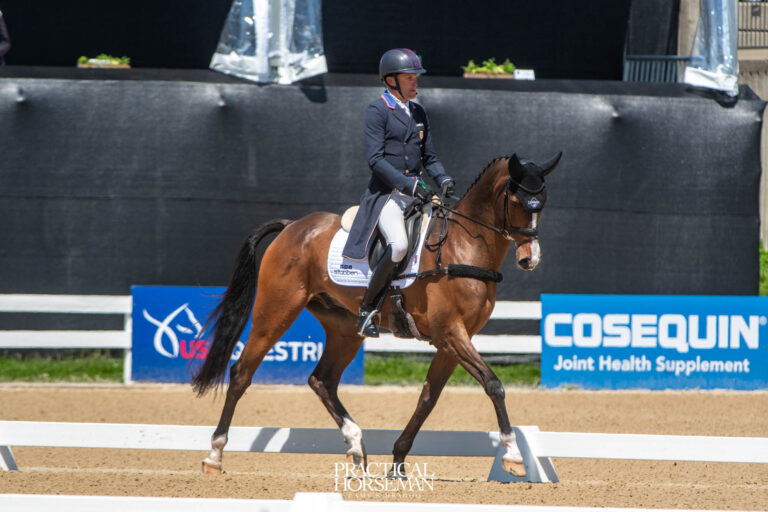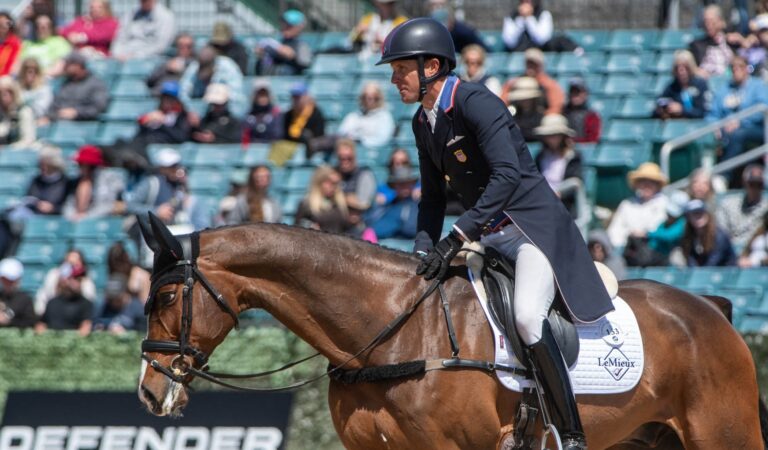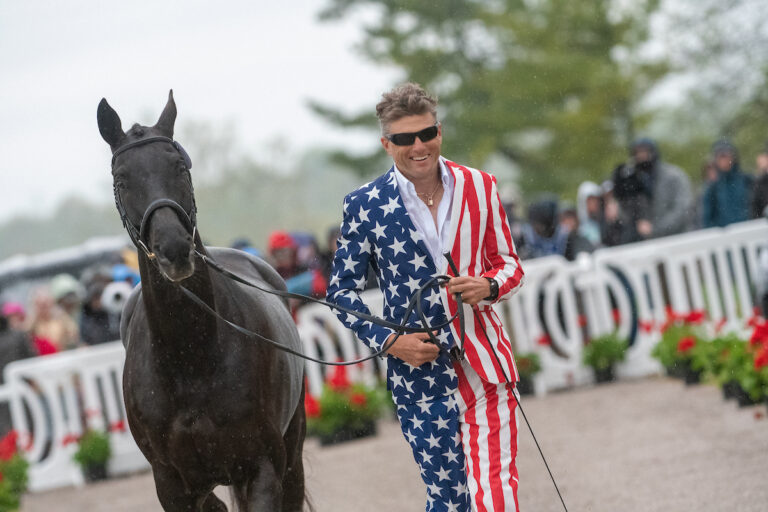The eight eventers and horses, ranging in levels from Introductory to Training, galloped over logs, through water jumps and sunken roads and up and down banks at Boyd Martin’s Windurra USA stables. Under the watchful eye of the three-time Olympian, they worked on their positions, contact, pace, feel and more.

Despite the exposure to a variety of fences, exercises and skills, Martin’s main message for the group was streamlined: “The take-home is, if you take [thousands of] lessons and can keep one thing, it’s money well spent. Make sure you take one thing and drive it home.”
The morning schooling sessions with Martin were the highlight of Practical Horseman’s Win A Day with Boyd Martin clinic, sponsored by SmartPak. Contest winner Merrilyn Ratliff of Parkville, Maryland, and seven friends trailered their horses to Martin’s stable in Cochranville, Pennsylvania, in early May to spend an activity-packed day.
In the morning, the riders participated in cross-country lessons with Martin. After that, Martin gave a tour of his stables. Then the group enjoyed seeing Martin’s wife, FEI-level dressage rider Silva Martin, train her upper-level horses. After lunch, they watched Martin cross-country school his four- and five-star horses, including Tsetserleg TSF, Luke 140 and Fedarman B with former U.S. team coach Erik Duvander. “It was very neat to see, and I learned a lot just by watching,” Ratliff said of the afternoon. From there, the group headed back to the stables where Martin’s barn manager Stephanie Simpson talked about how the staff care for the horses. The day ended with meeting Martin’s 2010 World Equestrian Games’ partner, the indomitable Neville Bardos, now 24 years old and enjoying retirement at Windurra.
“It was a great day,” Ratliff said. “Boyd was great at tailoring everything for everybody’s levels and challenges.”
As for her training takeaway: “My horse, Koda Bear, is very forward, and we learned a lot from Boyd about slowing down. Embracing the forward but also having a little more civility.”
Here are some additional takeaways that Martin shared with the riders.
Tip 1: Never let your horse think he has a reason to stop.
After a brief warm-up, Martin started both groups, which included green horses, by trotting over basic fences and logs. “These baby jumps—they could walk over,” he said, adding that “the hardest part of a session is the early parts where we’re getting them going.” If a horse stopped, he told riders “make it happen” to get the horse over the jump.
Similarly, when Martin later had riders school over a ditch, he reminded them, “It’s so much better if you can get over it the first time unscathed. If a horse stops, it’s a traumatic experience.”
Later Martin explained further: “With these green horses, [you want to] get to a place mentally where every cross-country jump they see, they’re going to go over. And even if they come back to a trot, they can bunny hop it. They never learn they get a second go at this,” he said, adding, “Now at the same time, you have to be responsible for selecting appropriate jumps.”
Tip 2: Create good position habits early.
Martin complimented teenage rider Lilian Flemming, but also emphasized being proactive about fixing some incorrect position habits: “Your horse is a Saddlebred. He’s got sort of a dishy back and head up, so it baits you into sitting in the lounge chair. You’ve got amazing natural ability and balance and talent, but you’ve got to correct this. Otherwise it’s going to be like if you were smoking meth. It’s just a real hard habit to kick.” Overall, he wanted her to sit lighter in the saddle over the cross-country exercises. “Don’t put your seat bone down. Your pockets should never slouch down in the saddle,” he explained.
At the end of the schooling session as Martin spoke to other riders, he continued to hit home his point when he saw Lilian slouching in the saddle at the standstill on Sam I Am. “See how you’re sitting there,” he said. “Sit up straight for one hour where you’re perfect. Then that creates good habits.”

Tip 3: Finesse the ride with greener horses.
Kelsea Blazek was riding a talented, green horse, Peanut, who got excited. “He gets an A-plus for doing everything we asked of him today. He’s a bit wild, so when he scoots off, you’ve got to try and not go ‘Aaahhg, get back here,’” Martin said, demonstrating from the ground pulling up and back with his hands. “See if you can finesse it. If you need to balance him, it’s going to happen over five strides, not one stride, just so he understands that slowing down is not sharp.”
Tip 4: Be quiet with your hands and gently follow your horse’s mouth.
Martin complimented Rachel McCumbers and her horse, BG Bella Donna. “Beautiful horse. Great riding,” he said, adding that for her takeaway, “Remember the big thing with the hand. We’re not going to throw the reins up toward her ears when you’re jumping. It just stems from you trying too hard to not hit her in the mouth. It’s like a good mistake, that you’re too kind. So it’s just a little soft follow.

Tip 5: Do less with your body at the jumps.
As Eliza Herman rode Dakota around some of the obstacles, Martin encouraged her to be still with her position, not throw her body at the fences. He also wanted her to go slower and soften more with the reins. “Your upper body, especially when the jumps are really low, like the ones we jumped to get going, to me you almost have to do nothing,” Martin said. “Sometimes the hardest thing is to do nothing. Less is more. The more you swing your body around, the harder it is to balance.”
Tip 6: If you have a big jumper, keep your body back at drop fences.
Continuing to emphasize position, Martin advised Sarah Kane to prepare for drop fences with Rolex, an 8-year-old Novice level horse. “Because he’s a big jumper, going down a drop, he’s going to jump big behind and he’s going to ping you forward,” Martin said. “You’ve got to almost brace yourself and lock your upper body back, anticipating that moment, because before you know it, it happens. Even on these smaller drops, I’d overdo it. Do it as if it’s a five-star drop. And then when you’re at the competitions, you don’t have think about it. It’s just premeditated.”
Tip 7: Dictate your pace and takeoff distance.
As they schooled, Ratliff’s horse was excited and raised his head and rushed the jumps. Martin challenged her to make sure she was in charge of their speed and ride the exercises like an equitation round. “Him just running at it like a lunatic, you’ll get away with it at the lower levels, but as you climb up the levels, the jumps are too complicated,” he said. “It’s not about teaching him about all different types of fences. It’s more about regulating the pace. Where I’m going with this is it might take you forever to get him back to the right speed. Then in six months’ time, it takes you 20 strides and 30 strides. And then in six months’ time, it takes you 10 strides. You’ve got to say, ‘OK, I’m going to get back to the place I need to get to.’ And it takes forever at the moment, but as the partnership builds, it’s going to be more and more efficient. It’s the same issue I’ve got. The big-time horses, they need to slow down in two strides.”
Later, Ratliff elaborated on her take-home lesson: “My takeaway is that we both need a little bit more discipline. I need more discipline to ask him for when he needs to listen and when he can go. And he needs more discipline in terms of listening to my half-halt.”

Tip 8: Stay organized and straight.
For eventing newcomer, Ilene Lundy, Martin encouraged her and her horse, Gizmo, throughout the session. “The biggest thing with your riding is trying to get in this place where you can hold him straight. The hardest thing is where you get a bit discombobulated, long reins, and then he’s sort of like an eel. He’s going through the field and you’re like, ‘Now go left, now go right.’ Get yourself reorganized as quick as you can because he’s a good jumper. … But remember this is not easy and it’s not meant to be easy and it takes time to get the hang of all this.”
After the groups finished their schooling sessions, Martin explained that it was OK if he gave instruction differently than their regular instructors. “It doesn’t mean I’m right and they’re wrong. It’s just what I see on the day and what’s worked for me over the years.”
More Takeaway Tips
Throughout the two training sessions of Practical Horseman’s Win A Day with Boyd Martin, sponsored by SmartPak, Martin shared several bite-sized tips. Here are few:
Adjust your stirrup irons. “You want the stirrup bar hitting the ankle bone. If you have too long a stirrup, you get a little left behind,” Martin explained as he gathered the riders around him to start the session. He then had them stand up in the irons and lean forward, keeping their upper bodies over their horses’ withers. “That way, the horse is not carrying you on his back anymore,” Martin said. He had them practice this position riding uphill on the flat and as they jumped.
First walk your horse into the water when schooling water obstacles before you try to jump it. “Even if you have the best jumper in the world, you want to walk in. It creates confidence. They can’t tell if it’s 6 inches deep or 6 feet.”
Approaching a jump, have a game plan, especially to a long approach. Martin explained this idea further to Rachel McCumbers as she approached a log into a water jump: “We want to give ourselves a good line and a good place, so they have a good understanding of which jump they’re going to jump.”
Grab mane. Martin encouraged many riders, including George “Scott” Waters on Brick House, dressed from head to toe in Maryland flag breeches and boots, to grab mane jumping out of the water jump as well as up a small table and to get their bottoms out of the saddle. “Your position and posture should be in a forward place so you don’t get left behind,” Martin said.
Think about your landing stride. On most fences, Martin wanted riders to maintain the light seat. “You’ve got to think of landing a little bit more efficiently. Your landing stride has to be a little lighter, so land and try to be a little lighter, unless maybe it’s a drop fence.”
Feel what you’re doing. As riders went over a line of two jumps then a sweeping right uphill turn to a rolltop, Martin encouraged them to jump the fences smoothly, softly and out of rhythm. “The biggest thing with cross country is that you’ve got to feel what they’re doing,” he advised.
This article originally appeared in the Summer 2023 issue of Practical Horseman.










